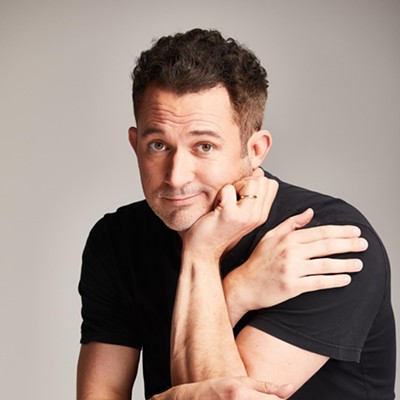In the evenings, she turns to dance, training her body to perform a whole menu of contemporary movements, in the studio and on the stage, with NEW ARTiculations Dance Theatre.
This weekend, her two passions merge in We Are What We Eat, an unusual dance concert about food, co-sponsored by NEW ART and the Food Bank.
"We Are We What Eat connects food issues--(which) have everything to do with our bodies, with an art form that uses our bodies," Morse says. "It makes all the sense in the world!"
Twelve professional NEW ART dancers, including well-known performers such as Katie Rutterer and Amy Barr-Holm, join with 13 community members to put on the show about food.
The concert has a "rich, local flavor," says Varga Garland, head of the Food Bank's food-security program, and one of four Food Bank staffers in the show. It covers everything from tortilla-making to grapefruit-picking to transporting tomatoes to Tucson plates.
The concert even moves out of the theater and into food arenas. A free preview of We Are What We Eat opens at 5 p.m., Thursday, April 24--the day this issue officially hits the streets--at the grand re-opening of the Santa Cruz River Farmers' Market, at the northeast corner of Speedway and Riverview boulevards. A free matinee at 2:30 p.m., Saturday, April 26, is right at the Food Bank, at 3003 S. Country Club Road. And the gala concert, at 6 p.m., Sunday, April 27, is at the Tucson Botanical Gardens, 2150 N. Alvernon Way. The $15 ticket at the door (or $12 in advance at Antigone Books) includes a sampling of local foods to eat--natch--and tours of the gardens. For more info, call the Community Food Bank at 622-0525 or NEW ART at 250-4664.
We Are What You Eat is a smorgasbord that goes back and forth between pure dance pieces by the dance pros and combo dances performed by the dancers and community members together. In between, community participants will "share their stories," says Kimi Eisele, NEW ART dancer and special-projects director, who coordinated the complicated collaboration.
But all of the work centers on food.
Tammy Rosen, a founder of NEW ART and mother of a toddler, choreographed a dance about breastfeeding, and the "problem of formula companies leading people away from breast milk," Eisele says. "It has mothers and babies in it," including Rosen and her daughter; LeighAnn Rangel Sotomayor and her son; and Polly Deason and her baby. The piece has NEW ART's usual playful touch: A cohort of sirens try to lure the moms away from the wholesome milk their own bodies produce.
Another dance is about "food preparation, about three cooks preparing food. The salt comes in. Then the chiles and the spices," Eisele says.
The community members, none of them dance pros, were coaxed into movement and storytelling in workshops that started clear back in October.
"Amanda and I co-led the sessions," Eisele says, working with multiple community groups from teens in a City High School class to women in a Pima Community College family-literacy program.
"We reached parts of the public we wouldn't normally as a modern-dance company," Eisele says. "We worked a lot with gestures, working from simple, everyday movement."
In the Pima sessions, Eisele and Morse had the mostly Latina women demonstrate the ways they make tortillas and tamales.
"The link between food and dance raised eyebrows at first, but then became clear," Eisele says. "We talked about how we grow food, how we prepare it, how we eat it. It's very physical."
The City High students helped create a piece about gardening. The teens brainstormed gestures--a boy wiping his sweaty brow, a girl making a cloud shape with her hands--and then the dance leaders "dancified it, played with it."
One of the community dancers, Barbara Eiswerth, runs the Refugee Gleaning Project, working mostly with African refugees, Eisele says. Eiswerth will bring along four of her clients to perform in the show--a trio of young siblings from Somalia, and another child from Madagascar. She'll tell the story of her nonprofit, whose volunteers fan out across town at the behest of homeowners to pluck backyard citrus fruit from overburdened orange and grapefruit trees.
Morse says she and her Food Bank colleagues struggle daily to think of new ways to make food more reliably available to everyone. They give out food boxes to families in trouble; they help locals plant backyard gardens.
The staff does a lot of "outreach and education," Morse says, but "it's still difficult to engage people in a more intimate, gut-level way about our food system and the food we eat."
She's hoping that art--in the form of dance--will get the message out.
"We believe that art can make this engagement possible," Morse says.











